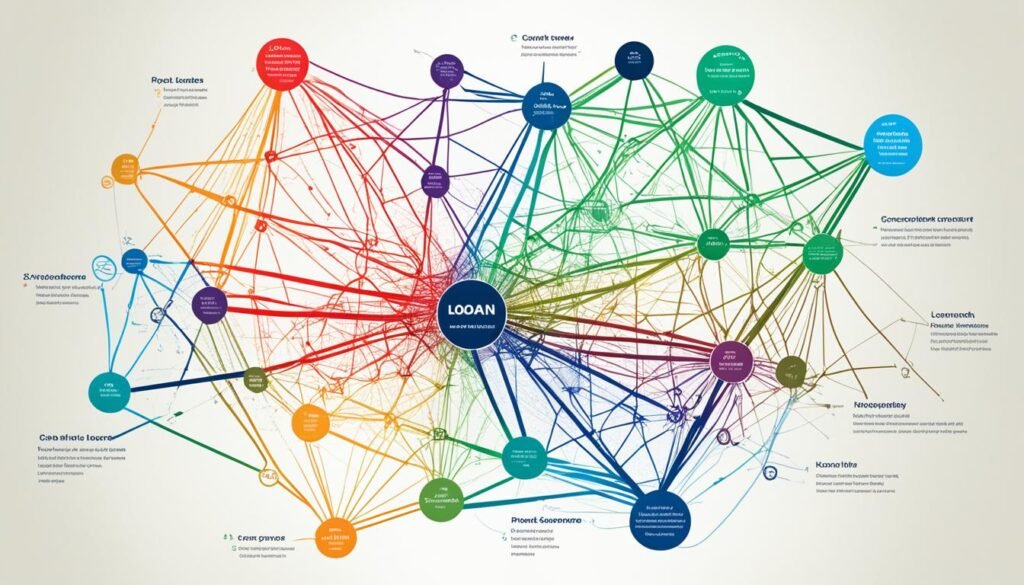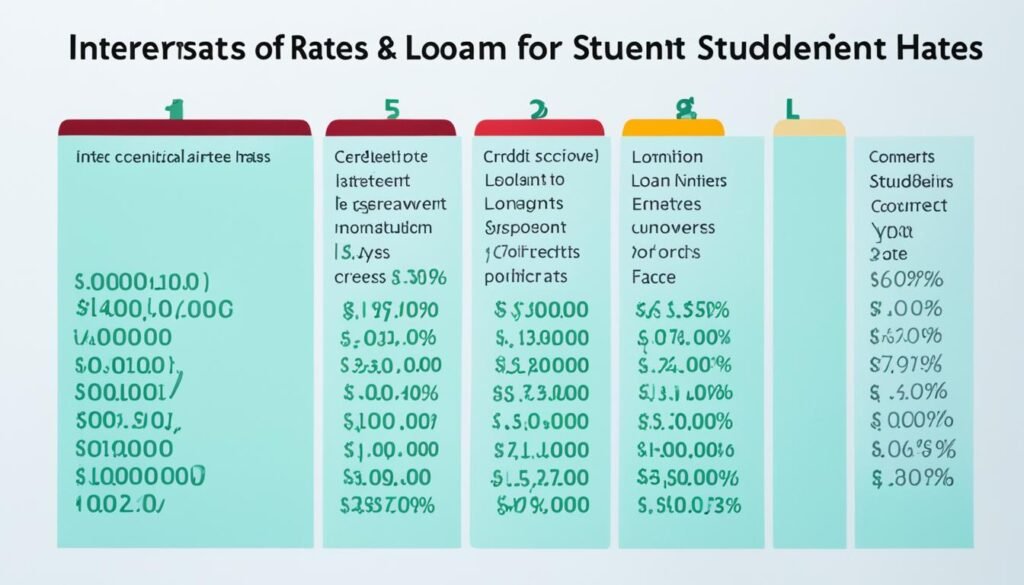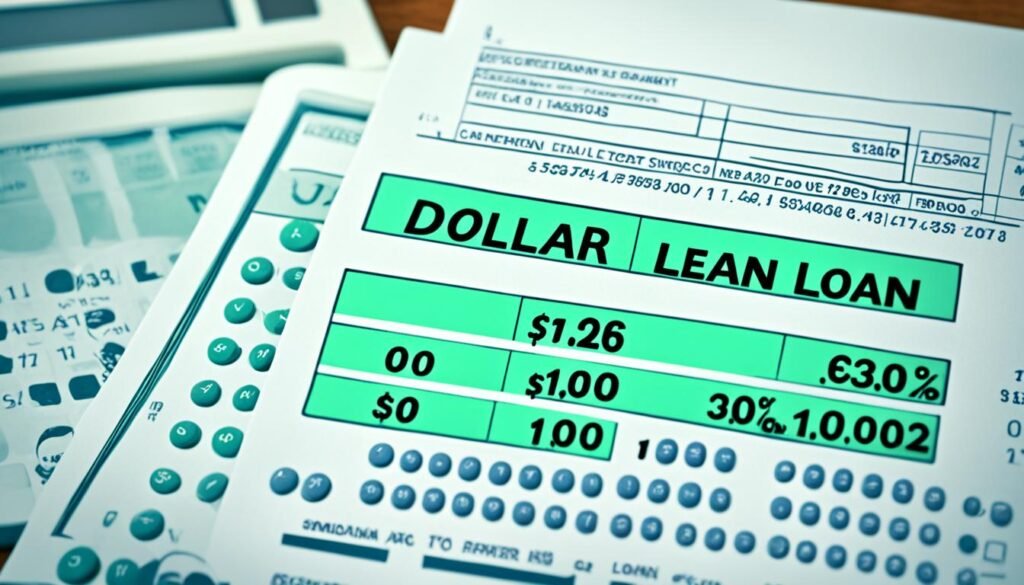When it comes to financing higher education, student loan interest rates are a critical factor that can significantly impact the overall cost of borrowing. These rates are determined by a complex interplay of factors, including the type of loan, the borrower’s creditworthiness, economic conditions, and government policies. Understanding the dynamics behind student loan interest rates can help borrowers make informed decisions and navigate the often-complex world of educational financing.
Federal student loan interest rates are set annually by the U.S. Congress based on a formula that ties the rates to the 10-year Treasury note yield, plus a fixed add-on that varies by loan type. In contrast, private student loan interest rates are determined by each individual lender based on their own underwriting criteria, such as the borrower’s credit score, income, and debt-to-income ratio. Additionally, broader economic factors like the prime rate and LIBOR can influence private student loan rates.
Navigating the landscape of student loan interest rates can be challenging, but being aware of the key factors that shape them can empower borrowers to make more informed choices. Whether opting for federal or private student loans, understanding how interest rates are determined can help borrowers minimize the long-term financial impact and find the best fit for their educational and financial goals.
Key Takeaways
- Federal student loan interest rates are set annually by Congress based on a formula using the 10-year Treasury note yield plus a fixed add-on.
- Private student loan interest rates are determined by individual lenders based on the borrower’s creditworthiness, loan terms, and broader economic conditions.
- Understanding the factors that influence student loan interest rates can help borrowers make informed decisions when choosing the right loan for their needs.
- Interest rates can have a significant impact on the overall cost of a student loan, so it’s important to compare options and explore strategies to secure the lowest possible rates.
- Monitoring interest rate trends and economic forecasts can provide valuable insights for borrowers as they plan for their educational financing.
Understanding Student Loan Interest Rates
Student loan interest is a crucial factor to consider when borrowing money for higher education. Interest rates represent the additional cost charged by lenders to borrow money, expressed as a percentage of the loan amount. Understanding the concepts of fixed interest rates and variable interest rates is essential for students to make informed decisions about their student loan options.
Definition of Interest Rates
Interest rates are the percentage of the loan amount that a borrower must pay in addition to the principal balance. These rates are set by lenders and can vary depending on the type of student loan, the borrower’s creditworthiness, and other economic factors. Understanding how interest rates work is crucial for understanding the overall cost of your loan.
Fixed vs. Variable Interest Rates
Student loans can have either fixed interest rates or variable interest rates, each with its own advantages and disadvantages. Fixed interest rates remain the same for the entire life of the loan, providing borrowers with predictable monthly payments and interest charges. In contrast, variable interest rates can change over time, typically based on market conditions, which can lead to fluctuations in interest that accrues and the overall cost of the loan.
| Interest Rate Type | Explanation | Advantages | Disadvantages |
|---|---|---|---|
| Fixed Interest Rate | Interest rate remains the same for the life of the loan |
|
|
| Variable Interest Rate | Interest rate can change over time, typically based on market conditions |
|
|
Federal Student Loan Interest Rates

The interest rates for federal student loans are set annually by the U.S. government, with the rates remaining fixed for the life of each loan. This means that the federal student loan interest rates and federal loan interest rates do not fluctuate during the repayment period, providing borrowers with predictability and stability.
How Federal Rates are Determined
The formulas for setting federal student loan interest rates are determined by Congress and are based on the 10-year Treasury note yield, plus a fixed add-on that varies by loan type. This formula ensures that the federal interest rates are aligned with broader economic conditions and government borrowing costs.
Direct Loan Interest Rate Formulas
The current interest rate formulas for federal direct student loans are as follows:
- Direct Subsidized Loans and Direct Unsubsidized Loans: 10-year Treasury note yield + 2.05%
- Direct PLUS Loans: 10-year Treasury note yield + 4.60%
These formulas result in federal student loans having fixed interest rates for the life of the loan, which can provide borrowers with greater financial stability and predictability.
Historical Federal Student Loan Interest Rates
Over the past decade, federal student loan interest rates have fluctuated, reflecting changes in the 10-year Treasury note yield and the fixed add-on set by Congress. For example, in the 2022-2023 academic year, the interest rates for federal student loans were:
- Direct Subsidized and Unsubsidized Loans: 4.99%
- Direct PLUS Loans: 7.54%
These historical trends in federal student loan interest rates and federal loan interest rates can provide valuable insights for borrowers as they navigate the federal student aid and federal direct loan application process.
Private Student Loan Interest Rates

While federal student loans have fixed interest rates set by the government, private student loan interest rates are determined by individual lenders based on a variety of factors. These include the borrower’s creditworthiness and credit score, the loan terms and repayment period, as well as broader economic conditions and market rates.
Creditworthiness and Credit Scores
Private lenders evaluate a borrower’s creditworthiness to assess the risk of the loan. This typically includes reviewing the borrower’s credit score, which serves as an indicator of their ability to repay the debt. Borrowers with higher credit scores are generally offered lower interest rates on private student loans, as they are perceived as less risky.
Student Loan Terms and Repayment Period
The loan term and repayment period can also influence the interest rate on a private student loan. Longer repayment terms, such as 10 or 15 years, may result in higher interest rates compared to shorter-term loans. Additionally, the loan amount and the borrower’s debt-to-income ratio can play a role in determining the offered interest rate.
Economic Factors and Market Rates
Broader economic conditions and market rates can also impact the interest rates on private student loans. Factors such as the prime rate, LIBOR, and SOFR (Secured Overnight Financing Rate) can influence the variable-rate loans offered by private lenders. Additionally, the overall state of the credit market and investor demand for student loan-backed securities can affect the fixed-rate loans available to borrowers.
Factors Influencing Private Loan Rates

When it comes to private student loans, the interest rates are determined by each individual lender based on their own underwriting criteria. The key factors that influence the rates offered by private lenders include:
Lender’s Criteria
Private lenders assess a borrower’s creditworthiness, including their credit score and creditworthiness, to determine the appropriate private student loan or private loan interest rates. Applicants with higher credit scores and stronger financial profiles typically qualify for more favorable rates on private and rates on private student loans.
Income and Employment
A borrower’s income and employment status play a significant role in the private loan interest rates and private student loan interest rates offered by lenders. Applicants with stable, well-paying jobs and consistent income are more likely to receive lower private student loan rates.
Debt-to-Income Ratio
In addition to income and employment, private lenders also consider an applicant’s debt-to-income ratio when determining private student loan rates. Borrowers with a lower debt-to-income ratio, indicating they have the financial capacity to manage additional debt, may qualify for more favorable interest rates on their private loan.
Comparing Federal and Private Loan Rates

When evaluating federal student loans and private student loans, the key difference lies in how their interest rates are determined. Federal student loan interest rates are set annually by the U.S. government, with rates remaining fixed for the life of each loan. In contrast, private student loan interest rates are determined by individual lenders based on factors such as the borrower’s creditworthiness, loan terms, and broader economic conditions.
Borrowers typically benefit from the stability of federal student loan interest rates, which are often lower than the variable rates offered by private student lenders. However, private student loan rates may be more competitive for borrowers with strong credit profiles and favorable loan terms.
| Feature | Federal Student Loans | Private Student Loans |
|---|---|---|
| Interest Rate Determination | Set annually by Congress based on 10-year Treasury note yield plus a fixed add-on | Determined by individual lenders based on creditworthiness, loan terms, and economic factors |
| Interest Rate Type | Fixed interest rates that remain the same for the life of the loan | May offer both fixed interest rates and variable interest rates |
| Typical Interest Rates | Currently range from 4.99% to 6.54% for undergraduate federal loans | Typically range from 3% to 13% or more, depending on the lender and borrower’s creditworthiness |
| Eligibility | Available to all eligible students regardless of credit history or income | Lenders may have stricter eligibility criteria, such as minimum credit score and income requirements |
| Repayment Options | Offer various repayment plans, including income-driven options | Repayment plans may be more limited, but some lenders offer flexible options |
When comparing federal student loan interest rates and private student loan interest rates, it’s important for borrowers to consider their individual financial situation, creditworthiness, and long-term goals. While federal student loans typically offer more favorable and stable rates, private student loans may provide competitive options for those with strong credit profiles or specific borrowing needs.
Future Trends in Student Loan Interest Rates

According to projections from the Congressional Budget Office (CBO), federal student loan interest rates are expected to continue rising in the coming years. By the 2031-32 academic year, the CBO estimates that federal student loan interest rates could reach as high as:
| Loan Type | Estimated Interest Rate |
|---|---|
| Direct Subsidized Loans | 6.79% |
| Direct Unsubsidized Loans (Undergraduate) | 7.79% |
| Direct Unsubsidized Loans (Graduate) | 8.79% |
| Direct PLUS Loans (Parents and Graduate Students) | 9.79% |
These projected interest rate increases for federal student loan interest rates and federal loan interest rates are driven by expected interest rate trends and rate changes by the Federal Reserve in the coming years. As the economy and interest rates continue to evolve, rates may increase and rates may change further, potentially resulting in rate increases for both federal student loan interest rates and private student loan interest rates by 2024.
Borrowers should stay informed about these future rates and interest rate changes to plan accordingly for their student loan repayment strategies. Understanding how interest rates are set and could increase can help students and families make more informed decisions about their student loan interest rates and private student loan rates.
Student Loan Interest

Student loan interest is the additional cost charged by lenders to borrow money for educational expenses. This interest is expressed as a percentage of the loan’s principal balance and accrues over the life of the loan. The interest rate can be either fixed or variable, and it can have a significant impact on the overall cost of the loan.
The interest charges on a student loan are calculated based on the daily interest rate and monthly interest charge. The daily interest that accrues is typically a fraction of the annual interest rate, and it is compounded over the life of the loan, resulting in compound interest being charged on both the principal and any unpaid interest.
Borrowers should carefully consider the interest rate and interest charges when selecting a student loan, as these factors can have a significant impact on the overall cost of the loan and the monthly payments over the repayment period.
Calculating Student Loan Interest

Determining the interest on a student loan involves several key calculations to arrive at the daily interest rate and monthly interest charge. Understanding these interest calculations is crucial for borrowers to estimate the total cost of their student loans and plan their repayment strategy effectively.
Daily Interest Rate Calculation
The daily interest rate on a student loan is calculated by dividing the annual interest rate by the number of days in the year, typically 365 or 366 for a leap year. This daily interest rate is then applied to the loan balance to determine the daily interest accrual. The formula for the daily interest rate is:
Daily Interest Rate = Annual Interest Rate / 365 (or 366 for leap year)
Monthly Interest Charge Calculation
To calculate the monthly interest charge, the daily interest rate is multiplied by the loan balance at the beginning of the billing cycle, and then multiplied by the number of days in the billing cycle. This provides the total interest accrued during that billing period. The formula for the monthly interest charge is:
Monthly Interest Charge = (Daily Interest Rate × Loan Balance × Number of Days in Billing Cycle)
By understanding these interest rate calculations, borrowers can better estimate the total cost of their student loans, including the impact of compound interest over the life of the loan. This knowledge can help them make informed decisions about loan repayment strategies, such as making additional payments to reduce the loan balance and overall interest charges.
Strategies to Obtain Lower Interest Rates

As a student borrower, securing the lowest possible interest rate on your loans can significantly impact the overall cost of your education. Fortunately, there are several strategies you can employ to potentially obtain lower interest rates:
Improving Credit Score
One of the primary factors that lenders consider when determining interest rates is your credit score. By taking steps to improve your creditworthiness, such as paying bills on time, reducing debt, and checking your credit report for errors, you can position yourself to qualify for lower student loan interest rates.
Choosing a Co-Signer
If you have a limited or poor credit history, consider asking a co-signer with a strong credit score and stable income to co-sign your student loan. This can help you qualify for lower interest rates and potentially better loan terms, as the lender will assess the creditworthiness of both you and your co-signer.
Considering Loan Term Length
The loan term and repayment period can also impact the interest rate you receive. Generally, shorter loan terms with a lower loan amount and debt-to-income ratio may qualify for lower interest rates. Carefully evaluate your financial situation and strategies to determine the optimal loan term length that balances your monthly payments and overall interest costs.
Impact of Interest Rates on Overall Loan Cost
The student loan interest rates charged on a borrower’s loan can have a significant impact on the total cost of the loan over the repayment period. A higher interest rate will result in higher monthly payments and more interest charges paid over the life of the loan, ultimately increasing the overall loan cost.
For example, a student loan with a fixed interest rate of 5% and a 10-year repayment term will result in substantially less interest accrual and a lower total loan cost compared to a loan with a variable interest rate that starts at 7% and increases over time. The compound interest on the higher rate can significantly inflate the loan balance and overall repayment burden.
Borrowers should carefully consider the impact of student loan interest rates when selecting their financing options, as the interest rate impact can be the difference between an affordable loan repayment plan and one that stretches their budget. By understanding how interest rates affect the total loan cost, borrowers can make more informed decisions to minimize the financial burden of their educational investments.
Also Read: Top Career Education Loan For Students
Conclusion
In conclusion, student loan interest is a significant aspect of higher education financing, impacting borrowers long after graduation. Understanding how student loan interest accrues and compounds is essential for borrowers to make informed financial decisions. With the right knowledge and planning, individuals can minimize the long-term costs of student loans and manage their debt effectively. Exploring options such as federal loan subsidies, income-driven repayment plans, and loan refinancing can help mitigate the burden of student loan interest. Additionally, seeking financial aid counseling and resources can provide valuable insights into repayment strategies and loan consolidation options. Ultimately, addressing student loan interest requires proactive financial management and a comprehensive understanding of the terms and conditions of the loans. By staying informed and proactive, borrowers can navigate the complexities of student loan interest and work towards achieving their financial goals while managing their debt responsibly.
FAQs
Q: What factors determine student loan interest rates in 2024?
A: Student loan interest rates in 2024 are typically influenced by factors such as the type of loan (federal or private), the borrower’s creditworthiness, current market conditions, and whether the loan has a fixed or variable rate.
Q: How do federal loan rates compare to private lender rates?
A: Federal loan rates are usually lower than private lender rates, as they are set by the government and tend to have more borrower-friendly terms such as fixed interest rates and income-driven repayment plans.
Q: What is the average student loan interest rate for 2024?
A: The average student loan interest rate for 2024 can vary depending on the type of loan and the lender, but it is usually around 4-6% for federal loans and potentially higher for private loans.
Q: How does student loan refinancing affect interest rates and repayment?
A: Student loan refinancing involves taking out a new loan with a private lender to pay off existing student loans. By refinancing, borrowers may be able to secure a lower interest rate, adjust repayment terms, and potentially save money over the life of the loan.
Q: How can I find the best student loan rates?
A: To find the best student loan rates, you should compare offers from different lenders, consider factors such as fixed or variable rates, loan terms, and repayment options, and make sure to shop around for the most competitive rates and fees.
Q: What is the difference between fixed rate and variable rate student loans?
A: Fixed-rate student loans have a set interest rate that remains the same for the entire repayment period, providing predictability and stability. Variable-rate student loans, on the other hand, have interest rates that can fluctuate based on market conditions, potentially resulting in lower initial rates but higher risk of rate increases.
Q: How do student loan interest rates in May 2024 compare to previous months?
A: Student loan interest rates in May 2024 may vary from previous months based on economic conditions, lender policies, and government regulations. It’s important to stay informed about current interest rates and consider refinancing or consolidating loans if beneficial.





